Traditional Japanese Panel Art Traditional Japanese Kamakazi Panel Art
Collecting guide: 9 things to know about Japanese screens
Japanese screens (byōbu) are exquisitely cute emblems of wealth and ability. Matthew McKelway, Professor of Japanese Art History at Columbia University, offers an adept overview
'What'due south interesting in the development of screen paintings,' says Matthew McKelway, Takeo and Itsuko Atsumi Professor of Japanese Fine art History at Columbia University, 'is that we see a really broad variation of themes early on on. Some of the earliest literary accounts seem to describe native landscapes — rounded green hills, cherry blossoms, maple leaves and seasonal flowers — but by the late medieval catamenia nosotros accept examples that include human figures and narratives.'
Every bit screens became increasingly varied in subject field matter and mode, members of the merchant class became keen collectors. Many cute examples are held in Buddhist temples, some commissioned by the temples and others donated past patrons. Today, gilded screens are still produced and used on special occasions such as award ceremonies and weddings.
- 1
Among the earliest screen paintings in East Asia are examples in lacquer on wood from Six Dynasties Communist china (220-589 AD). The earliest consummate extant example in Japan, explains Professor McKelway, is from the Tōji temple in Kyoto, congenital in 796 Advert, depicting a 'Chinese recluse in a landscape with bright green pigments for the mountains'.
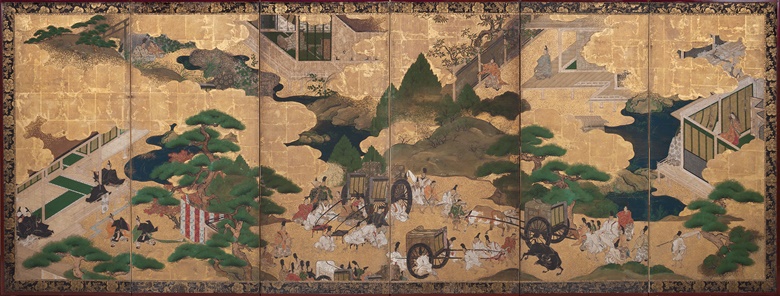
Anonymous (18th Century) Scenes from The Tale of Genji . Vi-panel screen. Ink, color, gold and gilt foliage on paper, 37½ 10 104¾ in (95.2 ten 266.1 cm). Estimate: $7,000-12,000. Offered in Edo to Mail War: 500 Years of Japanese Art and Design, 12 November to 19 November online
- 2
Screens were used every bit diplomatic gifts. 'From the tardily medieval period onward, they were sent in considerable numbers to Communist china and to Korea,' says McKelway. The subject of the screen paintings could frequently exist interpreted every bit a message to the recipient: 17th-century inventories describe images of Japanese warriors on screens sent to Korea — which is interesting considering Nippon invaded its neighbor twice in the 16th century.
Japanese screens also played an important part in the sacred setting of Shinto and Buddhist temples. 'The concept of shōgon is a décor used in the temple to raise and intensify the atmosphere for rituals,' the professor explains. 'The term encompasses the whole ensemble, from painted images and incredibly intricate silk borders on paintings to beautiful gilded incense burners and the like.'
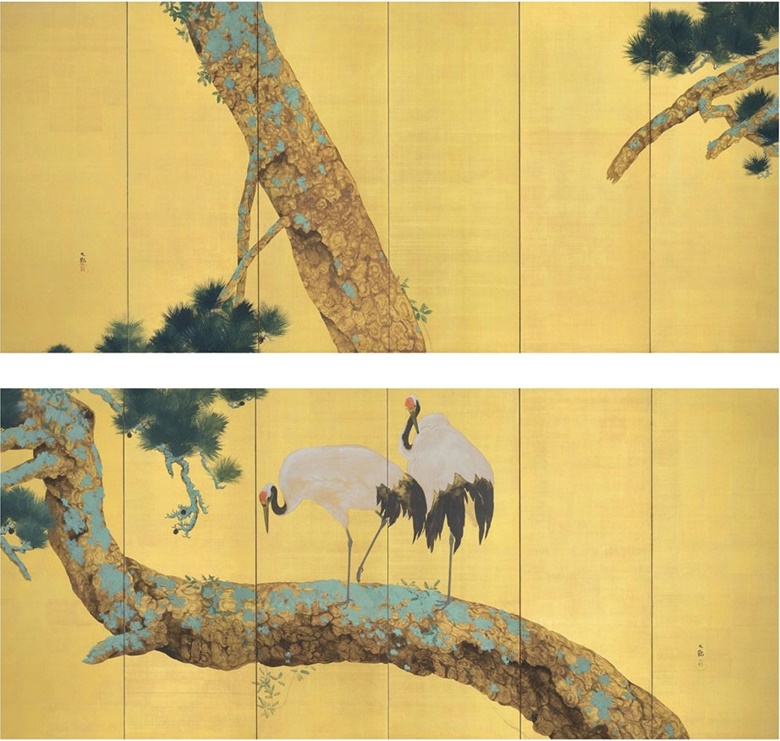
Yokoyama Taikan (1868-1958), Pine Trees and Cranes. Pair of six-panel screens. Ink, color, gold and gilt leaf on paper. 67 x 151⅛ in (170.2 x 383.9 cm.) each (2). Sold for $267,750 on twenty March 2013 at Christie's New York
They were also used at funerals and for the births of very high-ranking members of the aristocracy. Those serving the latter purpose, says McKelway, tend to be 'completely white or white with images of cranes or egrets painted on them.'
- 3
Screens often depicted images from the Tale of Genji, the classic work of Japanese literature written in the early years of the 11th century. Others, such equally those given as a dowry for a young married woman, might incorporate an underlying bulletin, such as management on how to behave at court.
- 4
Although many of the screens are unsigned, there are some famous names that stand out for their innovation and skill. 'Hasegawa Tōhaku — to whom this pair of screens of the Uji River is attributed — was attempting to do very unlike things with limerick and materials to his competitors in the Kano schoolhouse, for example,' says McKelway.
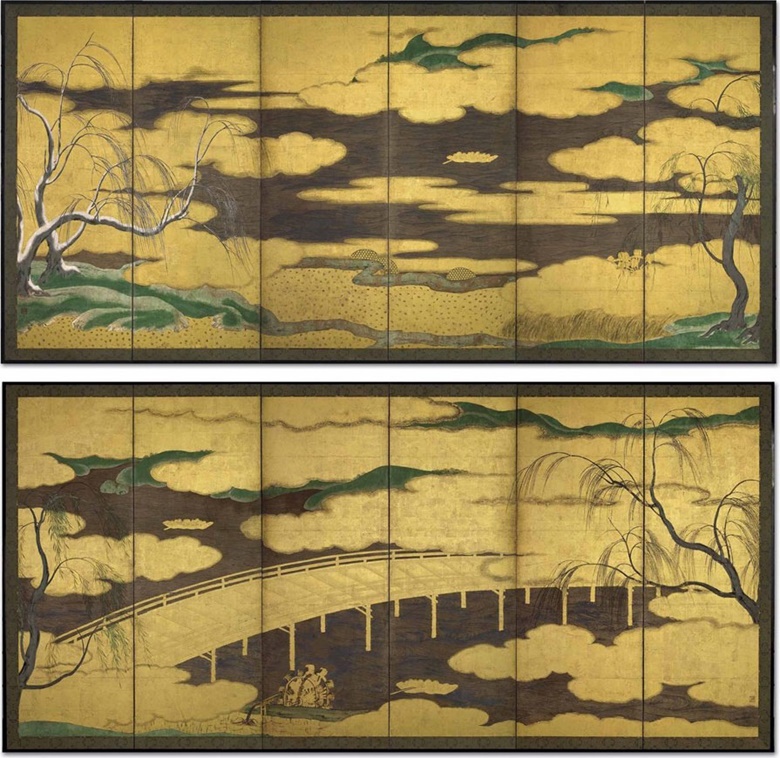
Attributed to Hasegawa Tohaku (1539-1610), Willows and Uji River. Pair of six-console screens. Ink, colour, gold, silver and gold foliage on paper. 62¾ x 139½ in (159.four x 354.3 cm) each. Sold for $605,000 on 22 April 2022 at Christie's New York
Effectually the 17th and 18th centuries, the artist's hand began to be prized as much as the subject or material and, just as in the West, the individual'southward work was often preferred to that of the studio.
Farther important names from this period include Maruyama Ōkyo, Nagasawa Rosetsu, Soga Shōhaku and Kishi Ganku. Yosa Buson, who was equally renowned as a haiku poet, is known to take established a lottery arrangement in order to raise funds for the finest materials, such as silk satin.
.jpg?w=780)
Anonymous (18th Century), Bamboo and flowers. 59⅛ x 68⅛ in (150.2 ten 173 cm). Estimate: $2,000-3,000 (£ane,585.xx - GBP 2,377.80). This lot is offered in Edo to Postal service-State of war: 500 Years of Japanese Art and Design, 12-19 November 2018, Online
- v
Signatures and seals began to appear on the screens in around the 16th century. 'An older, established painter who led a big atelier producing for a younger patron might enter his name in the lower corners of a pair of screens,' Professor McKelway notes. 'If an artist were painting a screen for the shogun, however, he might non want to be so bold equally to put his name on it.' The seals, meanwhile, more than commonly appear to betoken studio production.
- 6
There was a marked difference in materials from commission to commission. In the 16th century, for example, we see a growing preference for extensive application of metal foils, especially gold.
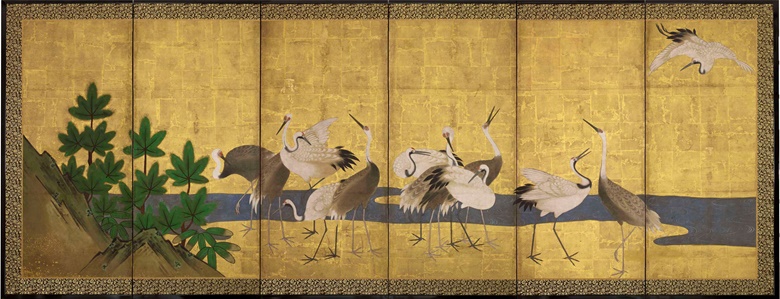
Anonymous, Edo Menstruation (18th century), Cranes and Pine. Half-dozen-fold screen. Sold for £12,500 online, 14-28 July 2015
Changes in Japan, such as national unification in the late 16th century, led to an advancement of technique. 'The late Momoyama period is considered by art historians to be the period of major compositional innovation,' says McKelway. 'By the end of the 16th century, greater political stability contributed to urban development and increasing competition among painting studios.'
From the late 17th century, the latitude of patronage for works of art widened considerably as cities like Kyoto, Osaka, Nagoya and Edo flourished, says the professor. The new consumerism was conspicuously displayed at the almanac Gion festival in Kyoto, when screens and other treasures were taken out and put on evidence. This was unusual within Japanese civilisation, with its emphasis on discretion.
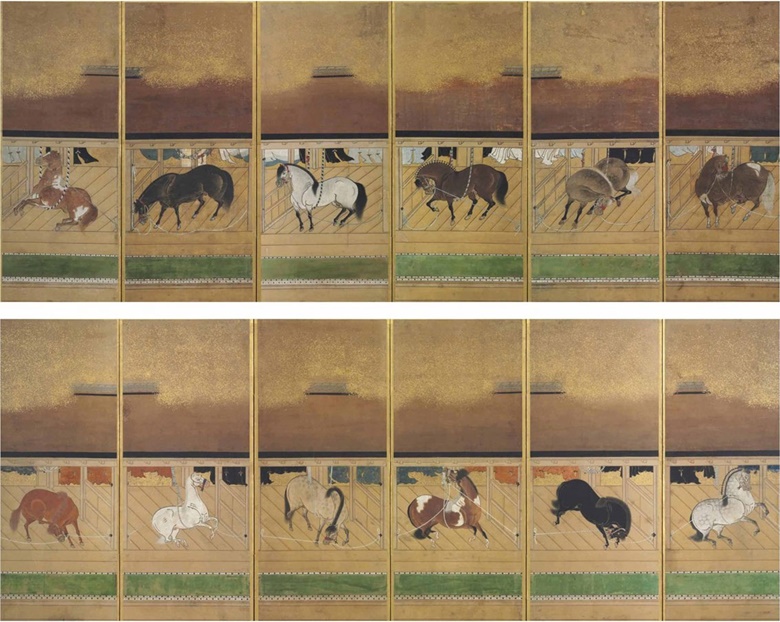
Anonymous (17th century), Stable with fine horses. Twelve paintings mounted as a pair of six-panel screens. Ink, colour and gold flecks on paper 52 x 19 ¾ in (132.1 x 5.ii cm.) each approx. Sold for $75,000 on fifteen April 2022 at Christie's New York
- 7
'The outset known Japanese folding screen to have been sent to the W was function of a Japanese embassy to Spain, Portugal and eventually to Rome in the 1580s,' explains McKelway. Due to their delicacy and rarity these gifts were not widely dispersed in the same way as, say, traditional fans or Chinese porcelain.
Every bit they began to exist caused by museums and major collections in the 19th century, Japanese screens appeared in the work of artists such as Whistler and Manet.
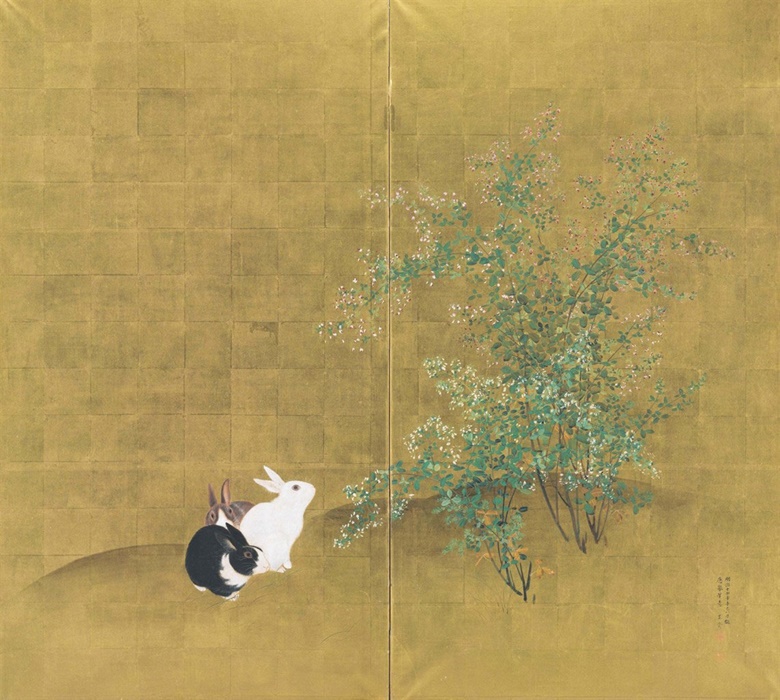
Mori Kansai (1814-1894), Rabbits, 1881. Two-panel screen. Ink, colour and gold leaf on newspaper. 65¼ x 72¼ in (165.7 x 183.2 cm). Sold for $eleven,875 on eighteen September 2013 at Christie's New York
- 8
Similar whatever work of art, painted screens require a peachy deal of care. As a rule, they should not be put up on walls considering the hinges will strain, causing damage to the framework and tears on the painting surface.
Temperature and humidity are too important considerations. 'Screens have to be kept in conditions similar to those in their place of origin,' advises McKelway.
- 9
Although the professor advises that one should always follow 1's own gustation, factors to consider include rarity, the quality of the painting and materials, the composition or theme and the screen's condition.
'The appearance of an artist's proper noun might be significant, merely because so many works were not signed it's important to focus on the power of the imagery and the control of the medium,' McKelway says. 'My sense is that screen paintings are still a real bargain, especially in comparison to some of the household names in Western art.'
Source: https://www.christies.com/features/japanese-screens-collecting-guide-7164-1.aspx
0 Response to "Traditional Japanese Panel Art Traditional Japanese Kamakazi Panel Art"
Post a Comment